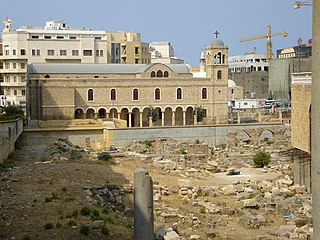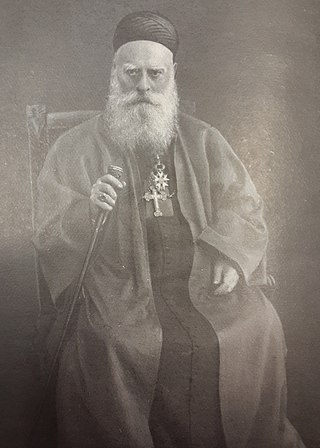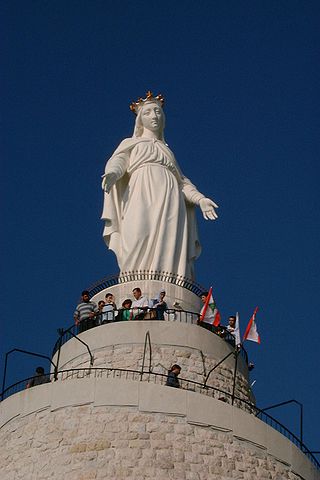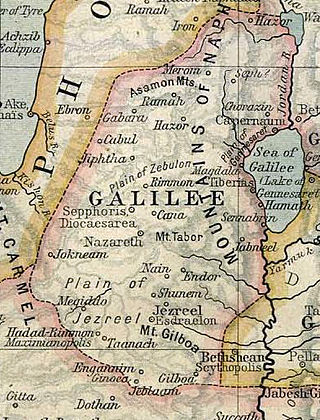Related Research Articles

This is a demography of the population of Lebanon including population density, education level, health of the populace, economic status, religious affiliations and other aspects of the population.

Beirut is the capital and largest city of Lebanon. As of 2014, Greater Beirut has a population of 2.5 million, which makes it the third-largest city in the Levant region. The city is situated on a peninsula at the midpoint of Lebanon's Mediterranean coast. Beirut has been inhabited for more than 5,000 years, and was one of Phoenicia's most prominent city states, making it one of the oldest cities in the world. The first historical mention of Beirut is found in the Amarna letters from the New Kingdom of Egypt, which date to the 14th century BC.

The Latin Church in the Middle East represents members of the Latin Church of the Catholic Church in the Middle East, notably in Turkey and the Levant. Latin Catholics are subject to the Latin Patriarchate of Jerusalem and employ the Latin liturgical rites, in contrast to Eastern Catholics who fall under their respective church's patriarchs and employ distinct Eastern liturgical rites, while being in full communion with the worldwide Catholic Church. Latin Catholics in the Middle East are often of European descent.

The Catholic Church in Lebanon is part of the worldwide Catholic Church under the spiritual leadership of the Pope in Rome.

Christianity in Lebanon has a long and continuous history. Biblical Scriptures purport that Peter and Paul evangelized the Phoenicians, whom they affiliated to the ancient patriarchate of Antioch. The spread of Christianity in Lebanon was very slow where paganism persisted, but it ultimately spread throughout the country, and even after centuries of Muslim rule, it remains the dominant faith of the Mount Lebanon region and has substantial communities elsewhere.

Berytus, briefly known as Laodicea in Phoenicia or Laodicea in Canaan from the 2nd century to 64 BCE, was the ancient city of Beirut from the Roman Republic through the Roman Empire and Early Byzantine period/late antiquity. Berytus became a Roman colonia that would be the center of Roman presence in the eastern Mediterranean shores south of Anatolia. The veterans of two Roman legions under Augustus were established in the city, that afterward quickly became Romanized and was the only fully Latin-speaking city in the Syria-Phoenicia region until the fourth century. Although Berytus was still an important city after earthquakes, around 400 CE Tyre was made the capital of the Roman province of Phoenicia. "Of the great law schools of Rome, Constantinople, and Berytus", the law school of Berytus stood "pre-eminent". The Code of Justinian was mostly created in this school.

The history of ancient Lebanon traces the course of events related to the geographic area in the Eastern Mediterranean of what is now known as Lebanon from the beginning of antiquity to the beginning of Arab rule.

Elias Peter Hoayek was the 72nd Patriarch of Antioch for the Maronites, the largest Christian Catholic community in the Levant, from 1898 to 1931 when he died.

The Shrine of Our Lady of Lebanon is a Marian shrine and a pilgrimage site in the village of Harissa in Lebanon.

Phoenicia under Roman rule describes the Syro-Phoenician city states ruled by Rome from 64 BCE to the Muslim conquests of the 7th century. The area around Berytus was the only Latin speaking and Romanized part of Aramaic-speaking Phoenicia.

Italy–Lebanon relations are relations between Italy and Lebanon. Both countries are members of the Union for the Mediterranean.

The Maronites are a Christian ethnoreligious group native to the Eastern Mediterranean and Levant region of the Middle East, whose members traditionally belong to the Maronite Church, with the largest concentration long residing near Mount Lebanon in modern Lebanon. The Maronite Church is an Eastern Catholic sui iuris particular church in full communion with the Pope and the rest of the Catholic Church, whose membership also includes non-ethnic Maronites.

There are about 53,000 to 75,000 Lebanese Uruguayans, or Uruguayans of Lebanese origin. The Lebanese are one of the larger non-European communities, though still not as large a group as most European groups. Relations between Uruguay and Lebanon have always been close.

Saint George Maronite Cathedral is the cathedral of the Maronite Catholic Archeparchy of Beirut, Archdiocese of the city of Beirut, Lebanon. Its construction, with a Neoclassical facade, interior and plan inspired by the Basilica di Santa Maria Maggiore, began in 1884 and ended in 1894.
Lebanese Argentine refers to Argentine citizens of Lebanese descent or Lebanon-born people who reside in Argentina. Many of the Lebanese Argentines are descendants of immigrants cultural and linguistic heritage and/or identity, originating from what is now Lebanon.

Ptolemais was an ancient port city on the Canaanite coast in the region of Palestine, in the location of the present-day city of Acre, Israel. It was also called Ptolemais in Canaan. It was an Ancient bishopric, which became a double Catholic titular see.

Lebanon–Mexico relations are the diplomatic relations between Lebanon and Mexico. Both nations enjoy friendly relations, the importance of which centers on the history of Lebanese immigration to Mexico. Both nations are members of the Group of 24 and the United Nations.
Gabriel ibn al-Qilai (in exact Arabic transcription: Jibrāyīl ibn al-Qilā'i, in Latin: Gabriel Benclaius or Barclaius, was born in 1447 in Lehfed, in the Byblos District, and died in 1516 in Cyprus. He was a Lebanese Christian religious, belonging to the Maronite Church. Al-Qilai joined the Franciscan Order in 1470 and was consecrated bishop of the Maronites in Cyprus in 1507.

The Catholic Church in the Middle East is under the spiritual leadership of the Pope in Rome. The Catholic Church is said to have traditionally originated in the Middle East in the 1st century AD, and was one of the major religions of the region from the 4th-century Byzantine reforms until the centuries following the Arab Islamic conquests of the 7th century AD. Ever since, its proportion has decreased until today's diaspora tendency, mainly due to persecution by Islamic majority societies. In most Islamic countries, the Catholic Church is severely restricted or outlawed. Significant exceptions include Israel and Lebanon.

This article lists historical events that occurred between 401–500 in modern-day Lebanon or regarding its people.
